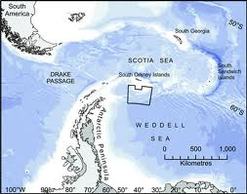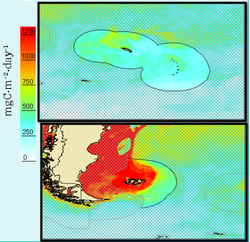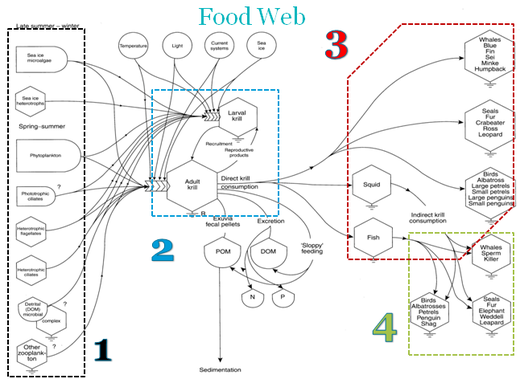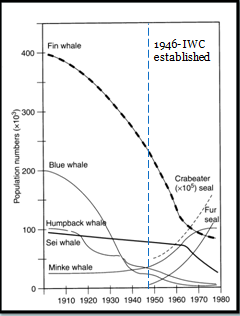Scotia Sea
Introduction
The Scotia Sea is located in the Southern Ocean and Southern Atlantic Ocean, roughly between the tip of Argentina and the Antarctic Peninsula. It is bordered by the Scotia Ridge on the North, East and South and by the Drake Passage on the West. (See figure on the right) It has an area of approximately 900,000 square kilometers, a little smaller than Venezuela.
This remote sea is extremely diverse and has become a center of many fishing operations. While these operations have caused, and continue to cause, numerous problems within the ecosystem of the Scotia Sea, the effective management of national and international organizations are helping to alleviate these effects.
This remote sea is extremely diverse and has become a center of many fishing operations. While these operations have caused, and continue to cause, numerous problems within the ecosystem of the Scotia Sea, the effective management of national and international organizations are helping to alleviate these effects.
Basic Characteristics
Area: 900,000 square kilometers
Type: Stormy, Polar
Temperature: Never exceeds 5 degree C
Average Depth: Between 3000 - 4000 m
Deepest Point: Meteor Deep, 7900 m
EEZs in Sea: Falkland Islands
South Georgia/Sandwich
Table of Contents
Basic Information
Currents
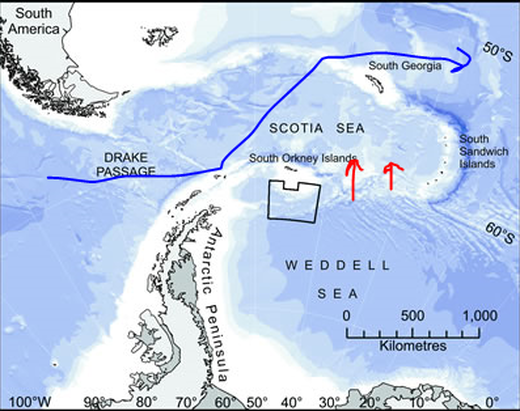
Major Currents in the Scotia Sea. Red is the WSSW and Blue is ACC [1] [2] Modified from WDCS International
The major current that is present in the Scotia sea is the Antarctic Circumpolar Current (ACC). This current comes from the West (the Drake Passage) and is immediately deflected North, due to the Scotia ridge, and eventually turns back East, going around South Georgia and continuing east through the Atlantic Portion of the Southern Sea. The Wendell Sea Surface Water (WSSW) is effectively constricted by the southern arm of the Scotia Sea, but is able to come through the Wendell-Scotia Confluence East of the South Orkney Islands. [2]
Primary Productivity
This polar sea has high levels of mixing. These high nutrient waters result in major phytoplankton blooms (primary productivity) when the waters are not light limited. In the pictures above, two Economic Exclusive Zones, or EEZ, are represented: the South Georgia/South Sandwich Islands and Falkland Island. The Falkland Island EEZ is relatively more productive because it lies in the shelf habitat and close to the South American Coast. Because of the extreme lack of light in this sea, the phytoplankton seasonal cycle is kind of a boom and bust
cycle. The "boom" happens October-November and the "bust" happens in June-July. This is extremely exaggerated in the Falkland Islands with a boom value of 2,210 mgC/m2ml and a bust value of below 200 mgC/m2ml. A similar cycle is seen in the South Georgia/South Sandwich Islands EEZ, but is less dramatic. [3]
Biodiversity
Habitat and Species Present
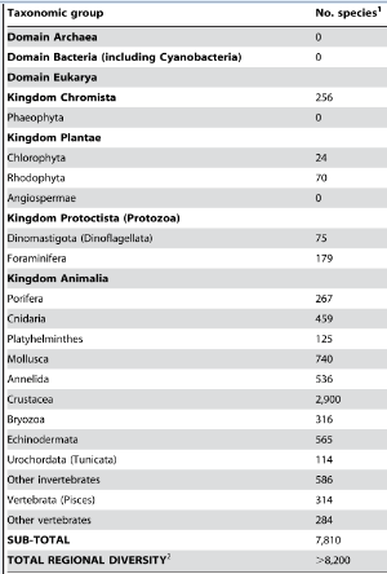
Table of Species Present in the Southern Ocean [4] Modified from 'Southern Ocean Ecology...'
The Scotia Sea is primarily consisted of two oceanic environments: Deep Ocean and Shelf. The average depth for the Scotia Sea is between 3000 - 4000 m and the deepest point is about 8000 m at Meteor Deep by the South Sandwich Islands, almost as deep as Mt. Everest is tall. About half of the sea is above the Continental Shelf. This sea is characteristically frigid, rarely exceeding 8 degrees Celsius and stormy. [25]
Much of the research for the biodiversity in the Southern Ocean applies to the Scotia Sea because it is part of the Southern Ocean. To the left is a table that shows the number of species found in each taxa of the Southern Ocean (applicable to the Scotia Sea) Notice the high biodiversity; that was not always thought to exist in these waters. [4]
Much of the research for the biodiversity in the Southern Ocean applies to the Scotia Sea because it is part of the Southern Ocean. To the left is a table that shows the number of species found in each taxa of the Southern Ocean (applicable to the Scotia Sea) Notice the high biodiversity; that was not always thought to exist in these waters. [4]
Below are some pictures of some of the more "charismatic" species present in the Scotia Sea. They are in order of trophic level (1 represents the bottom of the food chain, 4 the top). This animals can be found in both of the habitats described above.
Food Web
Below is a simplified food web for the Southern Ocean (which still is applicable to the Scotia Sea) that highlights the flow of energy from one trophic level to the next.
This food web is relatively simple with about 4 trophic levels, designated by the boxes in the diagram. Also, it is clearly a krill dependent food web, as all the species above Trophic Level 2 directly or indirectly consume krill. This is true of both the open ocean and the shelf environment although the species may differ slightly. For example, the shelf relies on the ice krill whereas the open ocean relies on the antarctic krill. [11]
Habitat Change
Change due to over-exploitation
The over-exploitation of both organisms at the top and bottom of the food web in the Scotia Sea are responsible for some of the changes seen, or that could be seen, in this ecosystem. The over-exploitation of whales, described in Historical Uses, dramatically changed the hierarchy of the predators of the essential krill. The top predators were whales, but after they were hunted, species of seals started to take the whales place at the top of the hierarchy. [11]
The over-exploitation of the krill in the future has the potential to dramatically change the entire food web as the food web is based on them. If the ecosystem moved from a phyto-krill to a phyto-copepod, many species present, such as whales, would not do as well. [11]
The over-exploitation of the krill in the future has the potential to dramatically change the entire food web as the food web is based on them. If the ecosystem moved from a phyto-krill to a phyto-copepod, many species present, such as whales, would not do as well. [11]
Historical Uses
Whale Hunting
Historically, the Scotia Sea has been used for hunting whales and seals. The extensive hunting of whales in this area (and the entire Southern Ocean) has caused a change in the food web. Before the massive whale hunting even in the 1900s, baleen whales were the number one consumer of krill. However, after the decline of their populations (see graph on right) some of the seal populations exploded and seals became the main consumer of krill and whales became the least influential consumer of krill. This shows the ramifications for over-exploitation of an important component of the food web. [11]
Major Fisheries
Falkland Island EEZ Fisheries
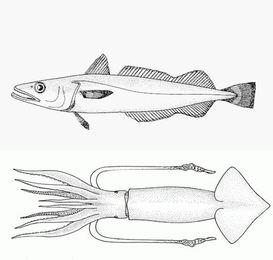
Top: Argentine Hake[14]. Bottom: Argentine Shortfin Squid[15]
The two most commercially fished organisms in the Falkland Island EEZ (partially within the Scotia Sea) are the Argentine Hake and the Argentine Shortfin Squid. Argentine Hake was preferred initially as a high trophic level white fish but has been over-fished and is now on the brink of extinction. [14] Due to the decreasing profitability of the Argentine Hake fishery, the Argentine Shortfin Squid has become commercially important. So far, it seems to be a fairly stable fishery. [15] The gear used in these fisheries has mostly been bottom trawls with the next common gear type being mid-water trawls.
South Georgia/South Sandwich Islands EEZ Fisheries
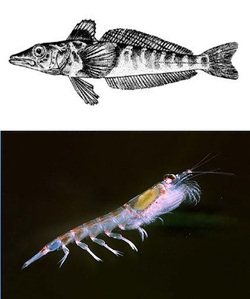
Top: Mackerel Icefish [7] Bottom: Antarctic Krill {8]
This EEZ is located, more or less, within the Scotia Sea. It is different than the one in the Falklands because the two most fished species, currently, are both low in the food web, while the two most fished species in the Falkland EEZ were relatively higher in the food web. The most fished species in this EEZ are the Mackerel Icefish and Antarctic Krill. They are both fished for the use in fish meal (used to feed terrestrial farm animals and farmed carnivorous fish) [3]. However, the Antarctic Krill fishery is especailly vulnerable because the entire food web (see Habitat Change) is dependent on the krill. [11] The krill fishery relies mostly on midwater trawls to catch the krill, which after the marbled rockcod were fished out in the late 1970s, became the most common fishing gear. The second most common gear type is the bottom trawl. [3]
Fisheries Management
Falkland Island EEZ Management
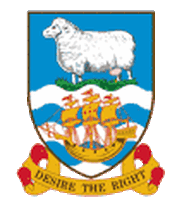
Crest of the FIG Fisheries Department [16]
Established in 1987, the Falkland Island Government (FIG) Fisheries Department is responsible for managing the Falkland Island EEZ. The most managed species for this organization are the two important squid species: Argentine Shortfin and Patagonia squids. Unfortunately, the Argentine Shortfin is highly migratory and is hard to manage because they share the population with neighboring Argentina. They also regulate the Argentine Hake and similar species but these fisheries are significantly reduced. The goal of this organization is:"The conservation of sustainable resources through effective management of fishing effort." [16] See the countries that fish this area here. [3]
South Georgia/Sandwich Islands EEZ Management
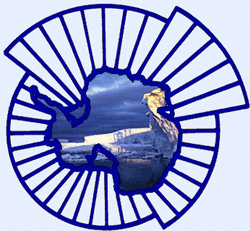
Crest of the CCAMLR [17]
The Commission for the Conservation of Antarctica's Marine Living Resources (CCAMLR) was established in 1982. The goal of the commission is "to conserve marine life of the Southern Ocean. However this does not exclude harvesting carried out in a rational manner." [17] The four target species of the commission to manage are the Antarctic Toothfish, the Patagonia Toothfish (marketed as the Chilean Sea Bass), the Mackerel Icefish, and Antarctic Krill. Three of there of these (not the Antarctic Toothfish) are included in this EEZ. This organization faces challenges due to krill exploitation as well as IUU fishing. Look here for a full description of management procedures by this organization. [17] Click here to find the countries that fish this area. [17]
For whale and seal management the International Convention for the Regulation of Whaling and the Convention for the Conservation of Antarctic Seals regulate each group of organisms respectively. [17]
For whale and seal management the International Convention for the Regulation of Whaling and the Convention for the Conservation of Antarctic Seals regulate each group of organisms respectively. [17]
Introduced Species
Mammalian Pests
Mostly on South Georgia Island, but some on the Falkland Island and others, these pests are present due to the use of this area for a fishery and whaling base. The species introduced included dogs, cats, rodents, etc. These animals cause havoc in some of the seabird populations, especailly breeding grounds. This has caused the birds to be forced to breed on small islands that are free from these pests. [18]
Invertebrates and some plants species have been introduced. but do not seem to be having much of an effect on the marine life in the Scotia Sea. However, additional research in this area would be useful. [18] In the future there is a concern that some species of king crab could potentially increase their range in the Southern Ocean by the effects of global climate change and the resulting warmer waters. This would have severe ecological consequences because the crabs are voracious predators and could overwhelm the food web. [24]
Invertebrates and some plants species have been introduced. but do not seem to be having much of an effect on the marine life in the Scotia Sea. However, additional research in this area would be useful. [18] In the future there is a concern that some species of king crab could potentially increase their range in the Southern Ocean by the effects of global climate change and the resulting warmer waters. This would have severe ecological consequences because the crabs are voracious predators and could overwhelm the food web. [24]
Pollution
Ozone Pollution
There is not a lot of pollution in the Scotia Sea because of its remote location. However, the hole in the ozone from anthropogenic sources has caused a marked decrease in primary productivity in the Southern Ocean (part of which is a section of the Scotia Sea). Also the increased UV radiation may damage some fish DNA. [20]
Plastic
A survey in 2008 found both good news and bad news regarding plastic pollution in the Southern Ocean. It found that while there was not a lot of plastic the debris was managing to reach areas of the ocean that have very little human contract. [19]
Issues Specific to Region
Over-exploitation of Species
The over-exploitation of marine mammals, which is more historical, and krill, which is more recent, can have major repercussions on the ecosystem. The over-exploitation of organisms from the top (marine mammals) or bottom (krill) of the food web can cause major changes within the food web. This changes can range from simply another animal, like seals, becoming dominant of the over-exploitation of the whales or the entire collapse of the ecosystem if krill was over-exploited as the entire food web depends on krill. [11]
Illegal, Unregulated, Unreported Fishing (IUU)
Essentially all of this fishing is done outside of the restrictions placed by the regulatory agencies. This is a huge issue as it can exacerbate the effects of the over-exploitation of species. [17]
Longline Fishing Interactions with Seabirds
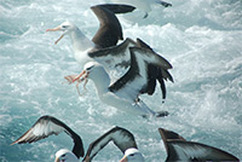
A group of black-browed albatosses feeding [21]
The increase of long line fishing in this region, especailly around the Falkand Islands, has resulted in increased mortality of seabirds, including the black browed albatross. These birds see the bait on the line and dive to get the bait and end up getting hooked on the line, dragged down in the water, and drown. This has been a major issue for the last couple decades and has resulted in a massive population decrease. This decrease is both due to the loss of the actual bird and the potential loss of the chicks of these birds. The loss of chicks happens because these birds are monogamous and when one of the pair dies, the surviving bird is forced to abandon their nest. This results in the death of the chick. Many of the birds affected by long lines are now listed as either endangered or threatened. [16][26]
Potential Solutions
Over-exploitation of Species
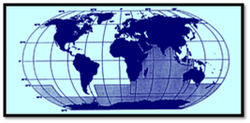
Dark blue indicates whale sanctuaries worldwide [22]
Various organizations involved in the Scotia Sea, described in the "Management" section, have set quotas and restrictions for the hunting/fishing of animals. For example, the IWC has designated the Southern Ocean as a whale sanctuary, meaning all hunting large whales is not allowed except scientific whaling. In addition CCAMLR has been doing numerous krill surveys to determine the appropriate quotas for a sustainable fishery. [22][17]
IUU Fishing
CCAMLR is approaching this issue with their Catch Documentation Scheme. The CDS essentially set forth additional rules to help control fishing such as GPS location of fishing boats within the fishery, recording of catch at first port, and lists of known offenders. [17]
Longline Fishing Interactions with Seabirds
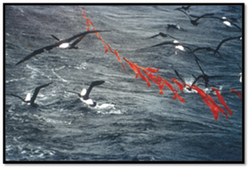
Bird Scaring Line [23]
Increased awareness and requirements of the Falkland Island Government are helping to alleviate this pressure on the delicate seabird populations. In addition a variety of mitigation techniques, including line weighting and bird-scaring lines, are outlined in a publication by the FIG Conservation group called Fishing Together in Harmony. [26]
References
1. Map of Scotia Sea
2. Southern Ocean Ecology: The BIOMASS Perspective
3. Seas Around Us - EEZ
4. Table of Species of the Southern Ocean
5. Black Browed Albatross
6.Emperor Penguins
7. Mackerel Icefish
8. Antarctic Krill
9. Blue Whale
10. Leopard Seal
11. Knox, G A. The Biology of the Southern Ocean. Studies in polar research. Cambridge [England: Cambridge University Press, 1994. Print.
2. Southern Ocean Ecology: The BIOMASS Perspective
3. Seas Around Us - EEZ
4. Table of Species of the Southern Ocean
5. Black Browed Albatross
6.Emperor Penguins
7. Mackerel Icefish
8. Antarctic Krill
9. Blue Whale
10. Leopard Seal
11. Knox, G A. The Biology of the Southern Ocean. Studies in polar research. Cambridge [England: Cambridge University Press, 1994. Print.
12. Phytoplankton
13. Killer Whale
14. Argentine Hake
15. Argentine Shortfin Squid
16. FIG Fisheries Department
17. CCAMLR
18. WWF Scotia Sea Ecoregion
19. Plastic Pollution
20. CIA Factbook 2010
21. Feeding Albatross
22. Whale Sanctuaries
23. Bird Scaring Line
24. King Crab Invasion of Southern Ocean
25. Scotia Sea - Encyclopedia Britannica
26. Fishing Together in Harmony
13. Killer Whale
14. Argentine Hake
15. Argentine Shortfin Squid
16. FIG Fisheries Department
17. CCAMLR
18. WWF Scotia Sea Ecoregion
19. Plastic Pollution
20. CIA Factbook 2010
21. Feeding Albatross
22. Whale Sanctuaries
23. Bird Scaring Line
24. King Crab Invasion of Southern Ocean
25. Scotia Sea - Encyclopedia Britannica
26. Fishing Together in Harmony
This page was created by Nick Hayman. Last modified 7 December 2010
